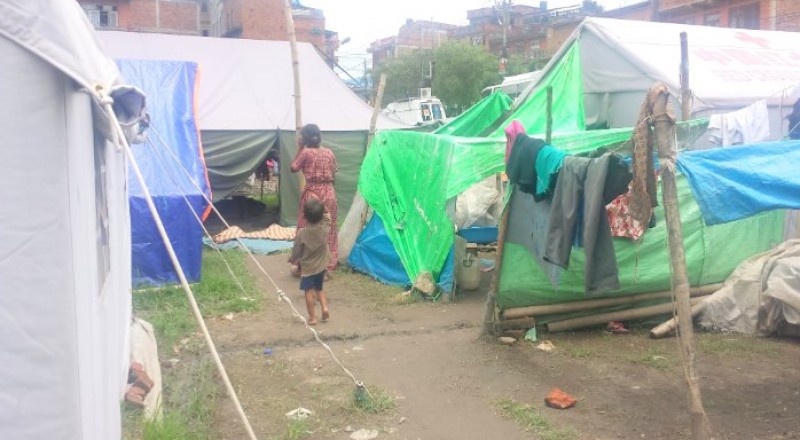Numerous people have been affected by the earthquake which hit the nation on April 25. They lost their loved ones, their house has been damaged and still after two months thousands of people are residing at the temporary camps. The TB patients are no different.
People living at the camp at Kamalbinayak of Bhaktapur complained that they are scared of sharing tents with TB patients. Bhaktapur is one of the worst hit districts of the quake, still many people are sleeping under tents. About 10 people sleep under a single tent which has the capacity of only 6 people.
When the team from Health Research and Social Development Forum (HERD) went to observe the site, few women with small kids were curious to know about TB and whether it easily transmitted or not. Dilu Bashyal, outreach worker of the TB REACH project gave them some information. One of the women said, “We have no option than sharing the tents as our house is destroyed. We don’t want the disease to be transmitted to our kids; we will use all the preventive measures but would want the TB patients to be alert too”.

Sitaram Dhatuwa, 43 has been under MDR (multi-drug resistant) TB medication since the last 13 months. He has been living under the big tent with 48 other people. Although he is unaware, the people sharing the tents are scared of the transmission of the disease, especially to children. Sitaram was diagnosed of TB when he visited the clinic after his skin became dark and he started losing weight. He was unaware about the disease. The doctors immediately began treatment. He said that he is quite satisfied with the treatment and visits the clinic in every 3, 4 days to receive the medicine.
On April 25, Sitaram only had medicines for two days. His house was damaged but he made sure that the earthquake terror didn’t affect his medication. He said, “I have felt a lot of difference in my body since I started the medicine. My appetite has improved and I feel healthy. I feel that whatever occurs, anyone undergoing MDR medication must make sure that it is not hampered because if so we will be so weak that we won’t be able to tackle it”.
Similar is the case with Ram Gopal Hyonjaju, 42 who is also under MDR medication. The locals including his family members were terrified to share the tent with him. He has been sleeping alone in the tent which has the capacity up to 6 people.
Since the earthquake, “District Public Health Camp” has been launched in various places of Bhaktapur. Radheshyam Karmacharya, Health Worker at Katunje Health Centre has been providing service through the camp at Kamalbinayak. Sharing his experiences he said, “Few TB patients come to the camp but most of them are neglecting its outcomes. Even if they notice symptoms, they only visit the camp if someone guides them”. He informed, “Some of the people residing at the camps have been looking for other places as they don’t want to share it with the TB patients. The locals are scared of its transmission”.

HERD Assistant Communications Officer Kritagya Regmi talking to Radheshyam Karmacharya, health worker at Katunje Health Centre
Except for few TB patients, patients with common cold and few suffering from diarrhoea visit the camp for treatment. Various health-related awareness campaigns are being run. Every Saturday, the people living in the camp clean the area. Radheshyam highlights, “All things are well managed except the place where the food is distributed. There are flies all over”.
The outreach workers of the TB REACH project have been actively involved in tracing the TB cases. They coordinate with the local bodies of the area and help run the screening effectively. Experiences of outreach workers in their own words:
“Currently it has been very difficult for us as maximum people go to the field to plant paddy. Last week we went to the camp at Kamalbinayak, Bhaktapur at 6 so that we don’t miss any case. It is not always easy as some understand the seriousness of disease while some are ignorant. The public is gradually getting information regarding the TB screening, its cost and importance. The level of awareness has increased to some extent compared to the initial days”- Maya Ghising

TB REACH outreach workers recording information of the screening
“We have reached all 35 wards of Kathmandu. People are being aware about the programme and various offices and hospitals have been sending patients for sputum test at HERD. The services available here is very expensive and we feel proud that we are contributing in providing free and quality service to TB patients” - Dilu Bashyal
The TB REACH project is being conducted by HERD since April, 2013. Two mobile vans have been deployed to various places of 22 districts namely Kathmandu, Lalitpur, Bhaktapur, Kavre, Chitwan, Makwanpur, Bara, Parsa, Sarlahi, Rautahat, Mahottari, Dhanusa, Kaski, Rupandehi, Kapilbastu, Dang, Banke, Bardiya, Doti, Acchaam, Kailali and Kanchanpur. The targeted population are slum, people living with HIV (PLHIV), household contacts of TB patients, factory workers, refugees and monasteries, diabetic patients and prisoners.
In the post-earthquake situation, the mobile vans have been deployed at some places of Kathmandu where target groups are displaced people living at camps. 600 screenings were conducted at Tundikhel camp with the support of Nepal Army. Likewise, 1500 and 500 screenings were conducted in temporary camps in Chucchepati and Bhaktapur respectively.



Comments(0)
No comments found.